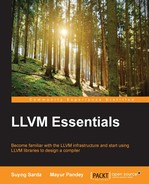LLVM is one of the very hot topics in recent times. It is an open source project with an ever-increasing number of contributors. Every programmer comes across a compiler at some point or the other while programming. Simply speaking, a compiler converts a high-level language to machine-executable code. However, what goes on under the hood is a lot of complex algorithms at work. So, to get started with compiler, LLVM will be the simplest infrastructure to study. Written in object-oriented C++, modular in design, and with concepts that are very easy to map to theory, LLVM proves to be attractive for experienced compiler programmers and for novice students who are willing to learn.
As authors, we maintain that simple solutions frequently work better and are easier to grasp than complex solutions. Throughout the book we will look at various topics that will help you enhance your skills and drive you to learn more.
We also believe that this book will be helpful for people not directly involved in compiler development as knowledge of compiler development will help them write code optimally.
Chapter 1, Playing with LLVM, introduces you to the modular design of LLVM and LLVM Intermediate Representation. In this chapter, we also look into some of the tools that LLVM provides.
Chapter 2, Building LLVM IR, introduces you to some basic function calls provided by the LLVM infrastructure to build LLVM IR. This chapter demonstrates building of modules, functions, basic blocks, condition statements, and loops using LLVM APIs.
Chapter 3, Advanced LLVM IR, introduces you to some advanced IR paradigms. This chapter explains advanced IR to the readers and shows how LLVM function calls can be used to emit them in the IR.
Chapter 4, Basic IR Transformations, deals with basic transformation optimizations at the IR level using the LLVM optimizer tool opt and the LLVM Pass infrastructure. You will learn how to use the information of one pass in another and then look into Instruction Simplification and Instruction Combining Passes.
Chapter 5, Advanced IR Block Transformations, deals with optimizations at block level on IR. We will discuss various optimizations such as Loop Optimizations, Scalar Evolution, Vectorization, and so on, followed by the summary of this chapter.
Chapter 6, IR to Selection DAG phase, takes you on a journey through the abstract infrastructure of a target-independent code generator. We explore how LLVM IR is converted to Selection DAG and various phases thereafter. It also introduces you to instruction selection, scheduling, register allocation, and so on.
Chapter 7, Generating Code for Target Architecture, introduces the readers to the tablegen concept. It shows how target architecture specifications such as register sets, instruction sets, calling conventions, and so on can be represented using tablegen, and how the output of tablegen can be used to emit code for a given architecture. This chapter can be used by readers as a reference for bootstrapping a target machine code generator.
